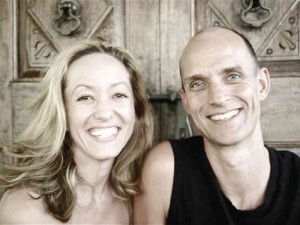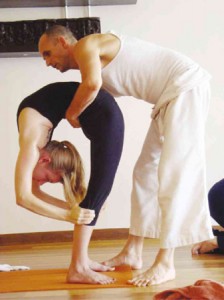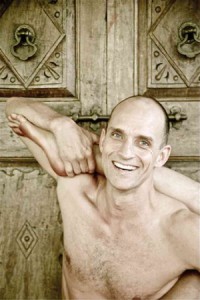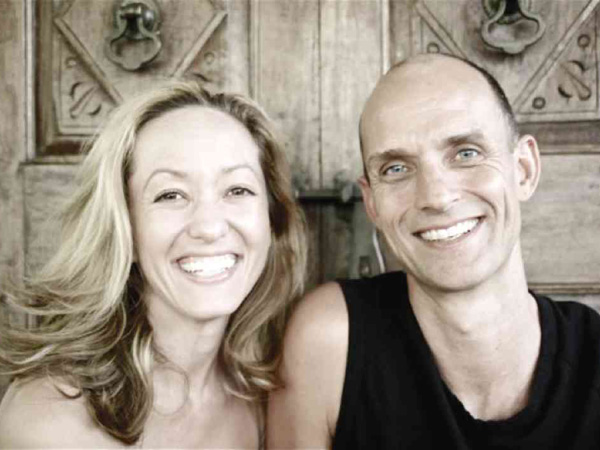
Yoga Manila welcomes Tim Feldman, a founding director of Miami Life Center and respected ashtanga teacher. Tim shares his in-depth knowledge on anatomy, alignment, and why he still feels more alive and “in tune” after two decades of practice.
“It was pretty big for me. I remember dropping a tear or two,” says Tim, about his first yoga class in 1994.
He was a young dancer in New York and badly hurt as a result of an accident in the mountains of Caracas, Venezuela. Tim was still in the process of rehabilitation—knees swelling, ligaments torn and a number of dance-related injuries.
“I could literally feel the healing effect on my body,” he recalls. “The challenge for me, at that time, was understanding the breath and simply acknowledging its relevance.”
Some irrational emotions surfaced, as well. “Forgiveness, asking for forgiveness, I had a hard time putting my finger on it, but it raised a long-lost issue I needed to set straight,” he reveals. “There was also a sense of coming home that accompanied that vulnerability. It was really quite life-giving.”
His first teacher, Lino Miele, set him on his path to ashtanga yoga. “I still hold him very dear,” he says. He continued his studies under the guidance of Guruji, the late vibrant Master Shri Pattabhi Jois, and then again later under Sharath Rangaswami.
“Guruji and Krishnamacharya defined this practice method. Pattabhi Jois put strong emphasis on the physical body as a tool toward greater self-knowledge,” he says of ashtanga yoga, a method that follows Patanjali’s eight-fold path toward self-realization.
The vinyasa way of linking the asana is unique to ashtanga, and makes for a dynamic practice.
Ingrained behavior

“Yoga is about addressing our habitual ingrained behavior, whether physical, mental or emotional. That is what we do on our mat every day,” says Tim. “We find, identify and transform innate patterns that are limiting.”
It’s more than exercise when you are connected to that deepest part of yourself. “We come to class with conditioned attitudes and ideas on how to approach a pose, then we discover an adjustment that would benefit us. Sometimes we learn the hard way through an injury, and sometimes we are ready to give up the old for the new enrichment,” he says with a smile.
“The breath, inclusive of the three main internal engagements/locks, or bandhas, constitutes the primary control in the ashtanga yoga practice,” explains Tim. “It calms the mind, soothes the nerves system and eases the muscles so that asana is possible.”
Done between sides and poses, the vinyasa “flushes” the body between asana, releasing the residue of a pose before attempting the next. “It provides a rhythmical constant, where the mind is stilled and deeper states can be reached,” he says.
Jump-backs and jump-throughs strengthen the pelvic floor (lower bandhas) as well as the upper and mid-torso. “There are more benefits, yet if done incorrectly, they can strain the body unnecessarily and create injury or fatigue in the joints, ligaments, tendons and muscles. As in every asana, the jump-throughs must be learned correctly and accurately,” he says firmly.
“If there is a sweetness to the practice, we naturally gravitate toward it. If it is too difficult, we will soon find ways to avoid it. Practice must have base levels of comfort and deliciousness for us to attend to it over a long time,” explains Tim.
“On the other hand, if we are inclined to only seek pleasurable stimuli, we will not accept the difficulty and discomfort of practice. For such challenges, a firm grip on ourselves, a disciplined attitude must be cultivated.” Between these two opposites, Tim stresses that we must try to pursue our potentials in life and on the mat.
Strength, confidence and a lot of heart-opening moments can help, as well. “Backbends can be an example of such a challenging moment, as fear easily arises from ‘dropping backwards into the unknown,’ often with some disconcerting discomfort in our lower spine,” he says.
“To overcome it, we must find it in ourselves to take the task, seek good information, technical accuracy, and then begin to patiently yet diligently allow the body to work on the rejuvenating and healing art of back bending.”
Organic
In 2006, together with wife Kino MacGregor and friend Greg Nardi, Tim founded the Miami Life Center in Florida, and has been traveling the world teaching and conducting workshops and Mysore classes.
“The practice is real, it has much to offer that you might not understand yet. As the method takes root, so does trust and dedication—your practice will straighten out organically,” he advises those who are starting.
For the seasoned student, “Make sure to define where your practice differs from Patanjali’s method and find a way to align yourself with his words—in that way, all is coming.”
Ultimately, it’s love and commitment that lead the student to self-discovery. “I just turned 46 and some injuries from my 20s are resurfacing. I need to ‘ask’ my body more than ‘tell’ it what to do—a dialogue one sets for a better practice,” he admits.

“When we begin our journey into yoga, we light the fire inside and it needs kindling to burn bright,” says Tim. “Regular practice is key and occasional workshops add significant aid to understand certain aspects in greater detail.”
This April 17-21, Tim will be in the country for a workshop with Yoga Manila. “It will be my first time in the Philippines. I hope to meet many of the local practitioners at any level. It is always a joy to see how yoga unfolds in different parts of the world,” he says.
Detailed look
“We will take a detailed look at technical and philosophical aspects of the practice, explore how to do backbends in a way that is safe and healthy, and work on a step-by-step method on jumping back and forward between the asanas,” says Tim.
“In class, we wish we had time to explore and understand what we are doing. In workshops, we have the space to try it differently under skilled and knowledgeable guidance. We can learn important keys which we can integrate directly into our practice.
“Workshops can be a place to have a little fun with it all; as one of my teachers used to say, ‘yoga is too serious to be serious about!’”
Advanced reservations are highly recommended. For details on workshop schedules and rates, visit www.yogamanila.com or call 0917-5229642. E-mail your questions/reservations to [email protected].













































